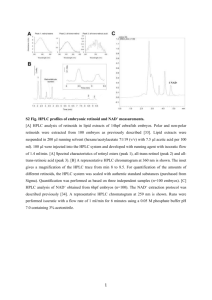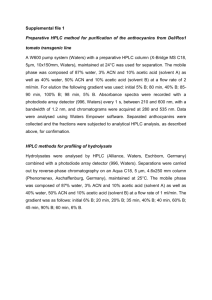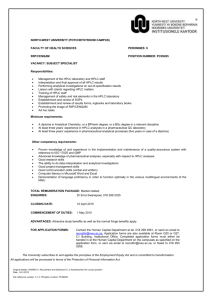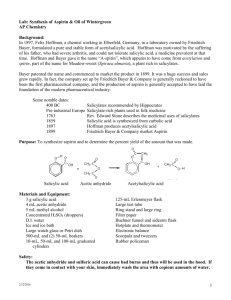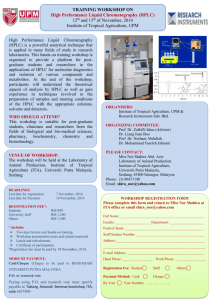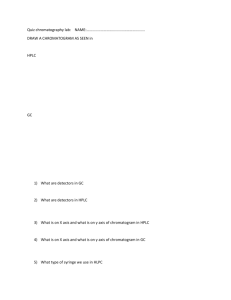Aspirin_2002
advertisement
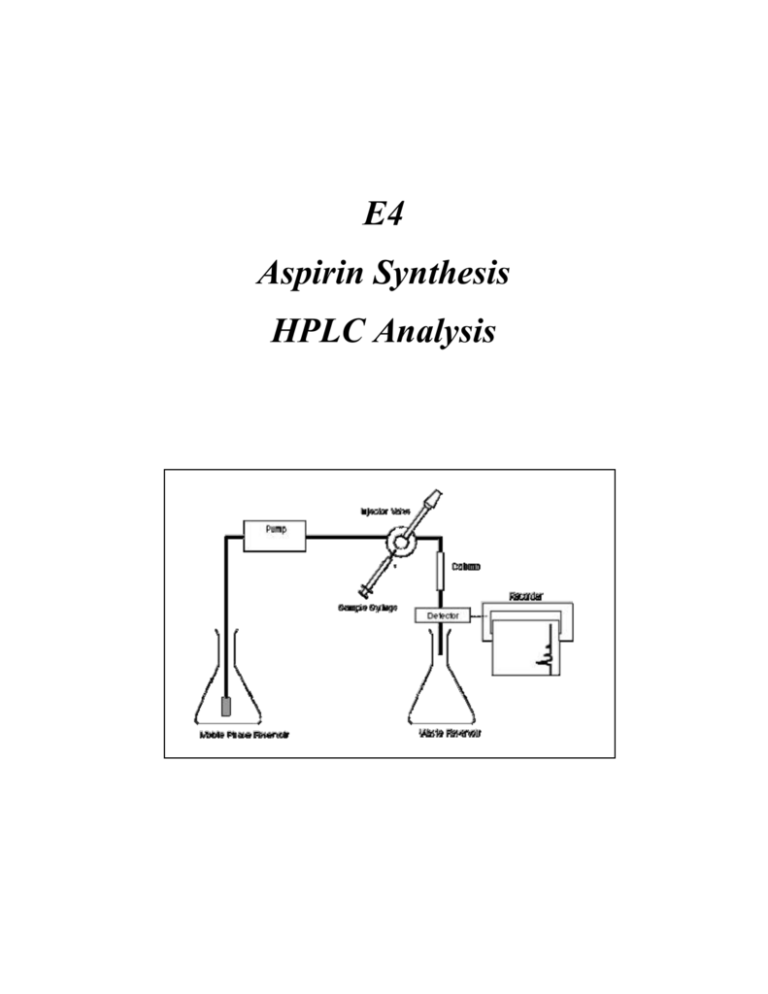
E4 Aspirin Synthesis HPLC Analysis C2507 Intensive General Chemistry – Spring 02 – E4: Aspirin Synthesis, HPLC Analysis E4 - Aspirin Synthesis. HPLC Analysis. INTRODUCTION Salicylic acid was first discovered in the bark of willow tree. It was widely used to cure fever and headaches. Later it was demonstrated that salicylic acid and its derivatives (organic compounds called salicylates) affected the production of prostaglandins in the body. Excessive amounts of prostaglandins in the organism can cause inflammation, fever and pain. Salicylates are said to have antipyretic activity, lowering body temperature, but have little effect if body temperature is normal. More importantly, salicylates are mild analgesics, relieving headaches, neuralgia and rheumatism. The use of salicylic acid was discontinued after the synthesis of aspirin. Its strong acidity had a series of side effects, mostly irritating the mucous membranes of the mouth and stomach. Although less acidic, acetylsalicylic acid can also cause the same problems to sensitive individuals, who use less acidic aspirin substitutes such as: acetaminophen and ibuprofen. O O O Acetaminophen (Tylenol) OH O OH OH H 3C OH OH O CH3 Acetyls alicylic acid (Aspirin) H 3C NH O Salicylic acid H 3C CH3 Ibuprophen (Advil) Common analgesics In the composition of commercial analgesics tablets there is also caffeine and buffer excipients such as aluminum hydroxide Al(OH)3, and/or magnesium hydroxide Mg(OH)2. E4 -2 C2507 Intensive General Chemistry – Spring 02 – E4: Aspirin Synthesis, HPLC Analysis O H 3C CH 3 N N O N N CH 3 Caffeine This experiment has a dual purpose: first to introduce you to preparative organic chemistry and second to use HPLC (High Performance Liquid Chromatography), to test the purity of the obtained product. In the first part you will synthesize acetylsalicylic acid from salicylic acid and acetic anhydride. After purification of the final product you will also analyze some commercial analgesic tablets to discover the usefulness of this technique as a quality control tool. THEORY Alcohols can combine with carboxylic acids under acidic conditions to form functional groups called esters. Esters can also be formed by the action of an organic anhydride (general formula RCO-O-COR) on an alcohol. One can easily make isoamyl acetate (better known as "Pear oil", used as a flavorant in mineral water and syrups) in this manner: O O OH HO is oamyl alcohol O O O O + OH Acetic anhydride is oamyl acetate E4 -3 HO Acetic acid C2507 Intensive General Chemistry – Spring 02 – E4: Aspirin Synthesis, HPLC Analysis This reaction is very similar to that of isoamyl alcohol with acetic acid: O O O OH + H 2O + HO isoamyl alcohol isoamyl acetate Acetic acid Both reactions are acid catalyzed, and both form isoamyl acetate. However, in the case of the acetic anhydride acetic acid is formed instead of water. The reaction you will perform involves the exchange of a phenolic hydrogen for an acetyl (COCH3) group which is supplied by the acetic anhydride. The anhydride is split half form aspirin and the other half form acetic acid. The severe conditions (concentrated H2SO4 and heating) serve to speed the reaction. Following completion of the reaction, the aspirin must be freed from the solvent (water), acetic acid, and unreacted acetic anhydride. Because the solubility of aspirin decreases with temperature, purification can be accomplished by cooling the reaction mixture, to initiate the formation of crystals. Often, to promote crystallization, the sides and bottom of the flask are scratched to provide a microscopically rough surface where the molecules can adhere to and build up as crystals. The subsequent filtration of these crystals removes the acetic acid and any unreacted acetic anhydride. O OH O O OH O O OH O + HO O OH O CH3 + HO Acetic anhydride Salicylic acid Acetylsalicylic acid (Aspirin) E4 -4 Acetic acid C2507 Intensive General Chemistry – Spring 02 – E4: Aspirin Synthesis, HPLC Analysis Any remaining contaminants are removed by recrystallization in a solvent in which aspirin is sparingly soluble. Aspirin separates then as crystals leaving impurities behind in solution. This process should give a relatively clean product, whose purity can be determined by melting point analysis. A sharp melting point -when all the crystals melt over a 1 - 2 degrees temperature range signifies purity. The purity of the synthesized aspirin will also be tested by comparison to commercial aspirin using HPLC. In this experiment, you will be introduced to HPLC through the analysis of analgesic tablets. First, you will chromatograph individual standard solutions of the tablets' components so that you can see their respective retention times. You will later compare the chromatograms of these standards and draw conclusions as of which one will be more retained based on its polarity. Then, you will choose a mixture of the standards and chromatograph that mixture under different conditions (e.g. different flow rate, detector attenuation, etc.) to observe the effects of these conditions on the chromatograms. Under the same conditions the aspirin sample you prepared should have the same retention time as the standard prepared with commercial samples. High Performance Liquid Chromatography (HPLC) Column chromatography, the oldest form of liquid chromatography, in which the stationary phase is packed in a column, and the eluting solvent allowed to percolate through the column under gravity, was refined greatly in the 1960's. During 1970's, most chemical separations were carried out using a variety of techniques including opencolumn chromatography, paper chromatography, and thin-layer chromatography. However, these chromatographic techniques were inadequate for quantification of compounds and resolution between similar compounds. During this time, pressure liquid chromatography began to be used to decrease flow-through time, thus reducing purification times of compounds being isolated by column chromatography. However, flow rates were inconsistent, and the question of whether it was better to have constant flow rate or constant pressure was debated; this lead to the development of high performance liquid chromatography, or HPLC. The technique is based on the same principles as column chromatography (i.e. partitioning between phases, the main difference is that the solvent is pumped through the column. E4 -5 C2507 Intensive General Chemistry – Spring 02 – E4: Aspirin Synthesis, HPLC Analysis HPLC is further characterized by the following features: 1. Reusable columns with small diameter (2 mm - 5 mm). 2. Small-particle (e.g. 3-10 µm) stationary phases. 3. Controlled and steady delivery of the mobile phase through the system. 4. Precise sample introduction using quality injectors. 5. Rapid analysis times. 6. High resolution. 7. The technique is less dependent on the operator's skill thus reproducibility is greatly improved. 8. A variety of flow-through detectors are available. 9. HPLC is applicable to over 80% of all known compounds and is the method of choice over gas chromatography (GC) for the separation of nonvolatile and thermally unstable compounds. In an HPLC system, a pump shoots the mobile phase through the system at the desired flow rate (Fig. 1). Fig. 1. HPLC System Block Diagram E4 -6 C2507 Intensive General Chemistry – Spring 02 – E4: Aspirin Synthesis, HPLC Analysis At the injector, the user inserts the sample for analysis. The injector is usually found right before the column. From there, the mobile phase picks up the sample and carries it through the column where it is separated into its various components. The separated components then travel through a detector cell where, based on the individual components' properties like UV absorption, fluorescence, or electrical conductivity, the amount of each component is determined. A recorder or another data-handling device translates the detector's electrical signals into peaks of various sizes. The most popular mode of HPLC is reversed-phase chromatography (RP-HPLC). In this technique, the stationary phase is non-polar (e.g. carbon chain bonded to silica) and the mobile phase is polar (e.g. methanol, water, acetic acid). This is opposite to normal phase HPLC where the stationary phase is polar (e.g. silica, alumina) and the mobile phase is non-polar (e.g. hexane). The length of the carbon chain of the stationary phase used in RP-HPLC is typically eight (C8) or eighteen carbons (C18). The separation is based on partitioning of the sample components between the mobile and stationary phases. Qualitative analysis Retention time, tR is widely used to identify the chromatographed peaks and the substances they represent. Under a given set of conditions, a particular compound will have a specific retention time. The unknown is compared to a known standard compound and, when the unknown is matched, the sample is identified. However, other compounds may have the same retention time. chromatographic conditions. Confirmation can be obtained by varying the Both the standard and the unknown should respond identically under the new conditions if they are, in fact, the same. A similar technique involves co-injecting the unknown with a known standard. This is done by adding the standard component to the sample and injecting the mixture, the unknown component and the standard should show up as the same peak in the chromatogram if they are the same compound. Other techniques used in advanced analytical methods include: (a) Using more than one detector to simultaneously test for different characteristics of the compound. E4 -7 C2507 Intensive General Chemistry – Spring 02 – E4: Aspirin Synthesis, HPLC Analysis (b) Chemically altering, or derivatizing, the compound of interest and seeing the changes on the chromatogram. (c) Using HPLC in conjunction with other techniques like mass spectrometry (MS) or infrared spectroscopy (FTIR). Quantitative analysis Once a peak is identified as an individual component, the next step would be to determine the amount of it present in the sample. This can be done from very accurate measurements of peak height or peak area. The concentration can then be determined using a calibration method. Peak height is measured from the baseline of the chromatogram to the peak maximum. The baseline is defined as the stabilized level of the recorder before the sample was introduced. The advantages of this technique are its simplicity and speed of calculation. However, there is a big disadvantage in that peak heights tend to vary much more than peak areas if chromatographic conditions vary. Peak areas also take into account any column degradation or longer retention, which results in wider, shorter peaks. Peak heights should only be used with symmetrical peaks. Peak areas may be determined by a variety of ways. The most widely used method being onehalf the peak height times the peak width (i.e. the area of a triangle). If all the components of a sample are detected, the concentration of each component in the sample may be expressed as a percent composition of the total sample: %Component Peak Height or Area Component 100% Total Peak Heights or Areas of Sample E4 -8 C2507 Intensive General Chemistry – Spring 02 – E4: Aspirin Synthesis, HPLC Analysis The actual determination of the amount of a certain compound in a sample uses a calibration method. One such calibration method is called external standardization. An external standardization plot of peak height or peak area versus concentration is drawn based on chromatographing a series of standards of varying concentrations of the compound of interest under a given set of conditions. Further information about HPLC can be found in Appendix A: Equipment and Techniques at the end of the manual and at the website. Also a tutorial on HPLC is available in the balance room of 302 Havemeyer. EQUIPMENT AND REAGENTS Salicylic Acid Acetic Anhydride Concentrated H2SO4 10mL vials 125 mL filtration flask, Hirsh funnel, 1.3 cm filter paper and #3 neoprene adapter 2mL pipettes 10µL micro syringe (blunt-pointed) Ibuprofen Acetaminophen Acetylsalicylic Acid Caffeine Bayer® aspirin Anacin® Excedrin® HPLC System Mobile Phase: 0.4% triethylammonium acetate, 13.8% methanol, and 85.8% H20 PROCEDURE Part I-a— Synthesis of Aspirin 1. Prepare a hot water bath: 250 mL water in a 400mL beaker. Adjust the hot plate setting in order to maintain the water temperature at around 85°C. 2. In a clean, dry 50mL Erlenmeyer flask, add approximately 0.50g salicylic acid (you must record the exact weight), 1.0mL acetic anhydride and 1 or 2 drops concentrated H2SO4. 3. Heat the mixture on a hot water bath for 10 minutes. Do not allow the water temperature to rise over 90°C. Add cold water if the water starts to become too hot. E4 -9 C2507 Intensive General Chemistry – Spring 02 – E4: Aspirin Synthesis, HPLC Analysis 4. Let the Erlenmeyer flask cool to room temperature, then add 6.6 mL of water and cool the flask on an ice bath for about 20 minutes. While keeping the flask in the ice bath, scratch the bottom of the flask (this step is essential!) with a glass-stirring rod, in order to induce crystallization. 5. Set up a suction filtration system with a 125mL filtration flask, a Hirsch funnel, a 1.3 cm diameter filter paper and a #3 neoprene adapter. Be sure to clamp the filtration assembly. Turn the aspirator on and slightly wet the filter paper to assure adherence to the funnel. 6. Transfer the contents of the Erlenmeyer flask to the filtration system using a glassstirring rod. Use the filtrate to rinse the flask and get out the residual crystals. Safety Note: Avoid contact with acetic anhydride and sulfuric acid. They cause severe burns and destroy cloth. Acetic Anhydride is very hygroscopic, close the flask immediately after use. Part I-b—Isolation and Recrystallization of Aspirin 1. Using the micro spatula, remove the crystals and the filter paper from the funnel and place them in a 100mL beaker. Dissolve the crystals with 1.7 mL of ethanol. Remove the filter paper. Use a warm water bath if necessary to complete dissolution. Do not heat directly on the hot plate. 2. Add 4.2 mL of hot distilled water over the crystals. Cool the 100mL beaker to room temperature. 3. Scratch the bottom of the beaker and place it in an ice bath until crystallization is complete. 4. Set up a suction filtration system as you did in step 5 of the synthesis. Filtrate the crystals, let suction pull air through the crystals for a few minutes to speed the drying. Weigh and label an empty 1” watch glass, record the weight. Collect the crystals on the watch glass. Spread them on the watch glass. Place this in the oven to dry the crystals for 10 minutes at 50°C. 5. Using tongs remove the watch glass from the oven and let it reach room temperature. Weigh the crystals. Take a melting point and an IR of the dry crystals. E4 -10 C2507 Intensive General Chemistry – Spring 02 – E4: Aspirin Synthesis, HPLC Analysis Part II —HPLC Analysis HPLC analysis will be simpler after using the HPLC tutorial PHENOMENEX. Basic Chromatographic Conditions: Column: Pecosphere 3x3 C18 Detector: UV (254 nm) Mobile Phase: 0.4% triethylammonium acetate, 13.8% methanol, and 85.8% water. 1. Prepare the aspirin crystals and the commercial tablets for analysis by grinding using a mortar and pestle. In each case, triturate the sample in the mortar with 10–15 mL of the mobile phase. 2. Transfer the mixture quantitatively into a 250-mL volumetric flask, dilute and shake to assure complete dissolution, and then dilute to the mark. This solution is diluted by a factor of 25 in a 25-mL volumetric flask. 3. Using the Millipore filtration system, filter a few mL of the solutions prepared into a small vial. Label the vials. 4. Using the Hamilton™ syringe, withdraw 10 µL of each one of the solutions prepared in step 1-3 and inject it into the HPLC. Wait until each sample is eluted 5. The instructors prepared vials with 1x10-4 M solutions of the individual compounds: ibuprofen, acetaminophen, acetylsalicylic acid, salicylic acid, and caffeine. 6. Inject 10 µL each of the pure compound solutions. Is there any correlation of the order of elution of the standard compounds and their structures? 7. Using a micro pipette prepare a 1:4:10 mixture of acetaminophen, caffeine, and acetylsalicylic acid solutions. 8. Inject 10 µL of the mixture to obtain a chromatogram of the three standards in a mixture. Exploring some HPLC Parameters For this part of the experiment you will work exclusively with the 1:4:10 mixture prepared in 7. Keep your printouts for analysis. Flow Rate Effect E4 -11 C2507 Intensive General Chemistry – Spring 02 – E4: Aspirin Synthesis, HPLC Analysis a) Re-analyze the 1:4:10 mixture as you did in step 8 above. b) Change the flow rate from 2.00 mL/min to 3.00 mL/min and re-analyze your sample. Change the flow rate from 3.00 mL/min to 1.00 mL/min and see the difference on the chromatogram. Chart Speed Effect Bring the flow rate back to its original 2.00 mL/min and wait a few minutes for the system to equilibrate. Switch your chart speed to 30 mm/min and re-inject the sample. Try it again with the chart speed at 10 mm/min. Be sure that the switch on the recorder for adjusting the chart speed is locked into the desired speed. If the switch is at an "in between" position, the recorder will not work properly. Attenuation Effect Finally, analyze your sample at an attenuation value (AUFS, Absorbance Units at Full Scale) higher and lower than the sensitivity used at the beginning of the procedure. Notes: (a) For a complete explanation on how to inject samples into the HPLC, ask your instructor. (b) All areas are expressed in mm2 , concentrations in mg/mL, and retention times in seconds. CALCULATIONS AND DISCUSSION 1. Determine the % yield of the acetylsalicylic acid. %yield moles of Aspirin Synthesized 100 moles of Limiting Re agent 2. Analyze the chromatogram of the aspirin you prepared. If there is any salicylic acid in your sample, calculate the % of it using the "area of the peak" method. Are there any other impurities? How can you tell? 3. Analyze the chromatograms of the pure components. Is the sequence of elution what you expected? Can this be rationalized in terms of the compounds' structures? E4 -12 C2507 Intensive General Chemistry – Spring 02 – E4: Aspirin Synthesis, HPLC Analysis 4. Calculate the % of the components in the chromatogram of the 1:4:10 mixture. Are there any discrepancies between the proportions calculated and the amounts you added? Is HPLC a reliable quantitative method? 5. Explain the effects of the parameters on separation. See the theory section on peak broadening. Attach the chromatograms for illustration. 6. Calculate the performance of the column in terms of Selectivity, number of theoretical plates, and resolution (See Appendix A). Use for this purpose the best chromatogram you obtained during the experiment. 7. In the formation of an ester from an alcohol and an acid water is formed. Suppose the reaction was conducted in a solvent different from water. In this case, what effect would removing water from the reaction mixture have? Would this have any effect on the yield of the ester? (Remember that this reaction is reversible). 8. Identify the analgesics preparations. The possibilities are TABLET Anacin Tylenol Bufferin Nuprin COMPONENTS Aspirin; caffeine Acetaminophen Aspirin Ibuprofen REFERENCES Pavia, D.L., Lampman, G. M., Kriz, G.S. Introduction to Organic Laboratory Techniques, 3rd ed. Saunders, Philadelphia 1988. Skoog, D.A. and Leary, J. Principles of Instrumental Analysis. Saunders, College Publishing Philadelphia 1992. S. A. Van Arman and M. W. Thomsen, Journal of Chemical Education, 49, 1997. E4 -13




